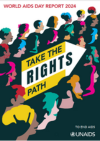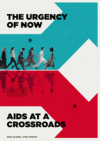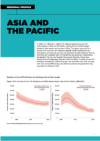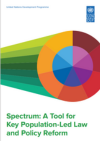Site Search
Displaying results 1 - 10 of 5054

Resource | Publications,
This report focuses on one of these essentials—the central role of human rights as it relates to ensuring access to HIV prevention and treatment services and addressing the structural determinants that increase vulnerability to HIV.

Resource | Fact Sheets,
Tuberculosis (TB) is a preventable and usually curable disease. Yet in 2023, TB probably returned to being the world’s leading cause of death from a single infectious agent, following 3 years in which it was replaced by coronavirus disease (COVID-19), and caused almost twice as many deaths as HIV/AIDS.

Resource | Fact Sheets,
In April 2024, the World Health Organization (WHO) updated its guidelines for the prevention, care, diagnosis, and treatment of people with chronic hepatitis B infection, which are aimed at helping policymakers and healthcare providers in low- and middle-income countries strengthen their efforts to address hepatitis B virus (HBV) and related national responses. The guidelines can also be used by civil society and community organizations to advocate for access to prevention, diagnosis, and treatment of HBV. This fact sheet summarizes the primary messages and recommendations.

Resource | Publications,
This report shows that world leaders can fulfil their promise to end AIDS as a public health threat by 2030, and in so doing prevent millions of AIDS-related deaths, prevent millions of new HIV infections, and ensure the almost 40 million people living with HIV have healthy, full lives.
Through powerful case studies and new data, the report shows how some countries are already on the right path—and how all countries can get on it.

Resource | Publications,
In 2023, 6.6 million [6.1 million–7.5 million] people living with HIV were residing in Asia and the Pacific, making this the world’s largest epidemic after eastern and southern Africa. The region accounts for a quarter of annual new HIV infections globally (23%).
People from key populations and their sex partners are disproportionately affected. Among countries with available data, HIV epidemics are growing in Afghanistan, Bangladesh, Fiji, the Lao People’s Democratic Republic, Papua New Guinea and the Philippines. Between 2010 and 2022, numbers of new HIV infections increased by 32% among gay men and other men who have sex with men and by 85% among non-client sex partners of people from key populations.

Resource | Publications,
Spectrum: A Tool for Key Population-Led Law and Policy Reform illustrates how people living with HIV, other key populations and their allies can strategically approach law and policy reform to remove barriers to HIV and health services in a combination of different ways.
The Spectrum can be applied to shape and structure the strategies and interventions for law and policy reform that are best suited to their realities.

Resource | Publications,
The Global Commission on HIV and the Law highlighted the significant role an enabling legal and policy environment plays in reducing HIV infections, specifically with respect to key populations. In the 2021 Political Declaration on HIV and AIDS, Member States pledged as part of the historic 10-10-10 targets that by 2025 less than 10 percent of countries will have punitive legal and policy environments that lead to denial or limitation of access to services.
Resource | Presentations,
Browse and view tables, charts and graphs illustrating data on the Tuberculosis-HIV (TB-HIV) situation in Asia and the Pacific.
Resource | Presentations,
Get an overview of the HIV/AIDS situation for Transgender populations. Browse and view charts and graphs illustrating data on this population's basic socio-demographic indicators, HIV prevalence and epidemiology, risk behaviors, vulnerability and HIV knowledge, HIV expenditures, and national response.

Resource | Publications,
The purpose of the new HIV response sustainability approach and the Roadmap is to secure the future of the HIV response, though not in isolation
from other priorities. The existing HIV response also must be transformed.
Many of the pertinent analyses, actions, and transformations to be undertaken require clear, well-crafted steps towards stronger health systems, betterintegrated services for HIV, stronger country ownership and more streamlined donor contributions to strengthen country systems.





